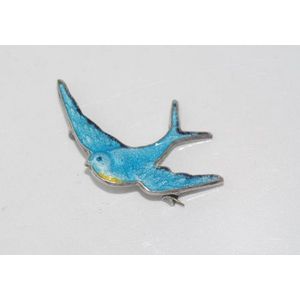Muriel Moody Salt Glazed Shag Sculpture
A good Muriel Moody (1907-1991) salt glazed sculpture of a shag, modelled with head raised, variable dark blue to its back, caramel to its front, the beak cracked and repaired, raised on mahogany square plinth base, the tail of the bird overhanging. Original exhibition label to base 'No. 5 salt glazed Bird...'. Height 50 cm. Note: Moody was a noted N.Z. commercial artist, welfare worker, sculptor and potter. Her lifelong interest in art included lessons with Harry Richardson. In the mid-1930s she moved to Christchurch, becoming the head of advertising for the department store Ballantynes. There she met other artists such as Rita Angus and Louise Henderson. In 1941 Moody joined the British YWCA War Service, working closely with the Director of Welfare for the Far East, fellow New Zealander Jean Begg, where she spent seven years in England, Egypt, Ceylon and India setting up residential, recreational and welfare clubs for servicewomen. In 1946 she worked in Japan to open clubs for women of the British Commonwealth Occupation Forces, including a Muriel Wilson Hostel. She settled in Days Bay, Wellington, where she set up kilns and began to specialise in pottery. In the 1950s she attended ceramics classes at the Petone Technical College with Wilf Wright, June Black, Mary Hardwick- Smith, Lee Thomson, Roy Cowan and Juliet Peter. She fired her larger salt glazed pieces in Roy Cowan's kiln in the Wairarapa. Further biographical details available
You must be a subscriber, and be logged in to view price and dealer details.
Subscribe Now to view actual auction price for this item
When you subscribe, you have the option of setting the currency in which to display prices to $Au, $US, $NZ or Stg.
This item has been sold, and the description, image and price are for reference purposes only.
- Mahogany - Mahogany is a dense, close grained red-coloured timber from the West Indies and Central America. It was first imported into Europe in the the early 18th century and its use continued through the 19th century. It was popular for furniture making because of its strength, the wide boards available, the distinctive grain on some boards, termed flame mahogany and the rich warm colour of the timber when it was polished.. The "flame" was produced where a limb grew out from the trunk of the tree, and this timber was usually sliced into veneers for feature panels on doors, backs and cornices.
Some terms used to describe mahogany relate to the country from which it originally came, such as "Cuban" mahogany, "Honduras" mahogany etc. However unless the wood has been tested the names assigned are more a selling feature, rather than a true indication of the timber's origin. - Salt Glazed - Salt glazing involves throwing salt into the kiln when it is at its highest temperature, usually around 2,300 to 2,400 degrees Fahrenheit (1,260 to 1,320 degrees Celsius). The salt vaporizes and forms a glaze on the surface of the pottery, creating a range of effects depending on how the salt is applied and the firing conditions. This glazing method was first developed in Germany in the 15th century and quickly became popular throughout Europe and North America. It was particularly popular for making stoneware pottery, such as jugs, crocks, and other utilitarian objects.
Salt glazes can produce a range of colors, including gray, brown, blue, and even pink or purple in some cases. The texture of the glaze is typically rough and pebbled, with a matte or satin finish. The process of salt glazing can be unpredictable, with variations in temperature and salt application leading to subtle variations in the finished product.
Salt glazing is still used by potters and ceramic artists although it is less common than it was in the past.
This item has been included into following indexes:
Visually similar items

Silver and enamel blue bird brooch
Sold by
in
for
You can display prices in $Au, $US, $NZ or Stg.

A Beswick porcelain Drake figurine, model 902, 25 cm high, together with a Beswick porcelain pheasant, model 850, 15 cm high
Sold by
in
for
You can display prices in $Au, $US, $NZ or Stg.

A colonial 15ct. gold Australian kangaroo bar brooch, 3gms.
Sold by
in
for
You can display prices in $Au, $US, $NZ or Stg.

Picasso, female figure, glass, faded inscriptions to base 'E. Costantini Pablo Picasso Fucina degli angeli Venezia'
Sold by
in
for
You can display prices in $Au, $US, $NZ or Stg.
